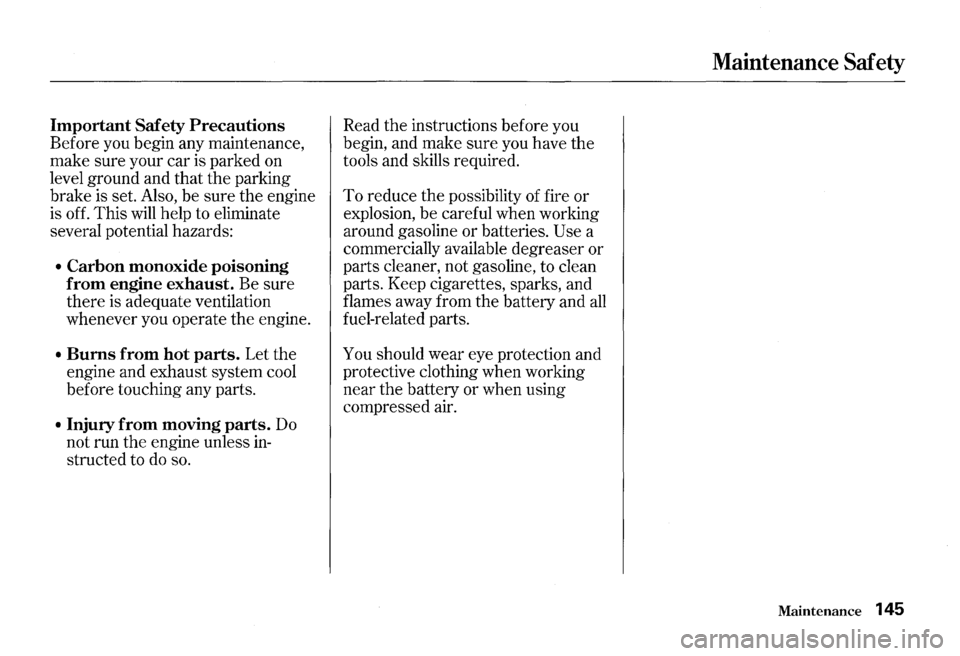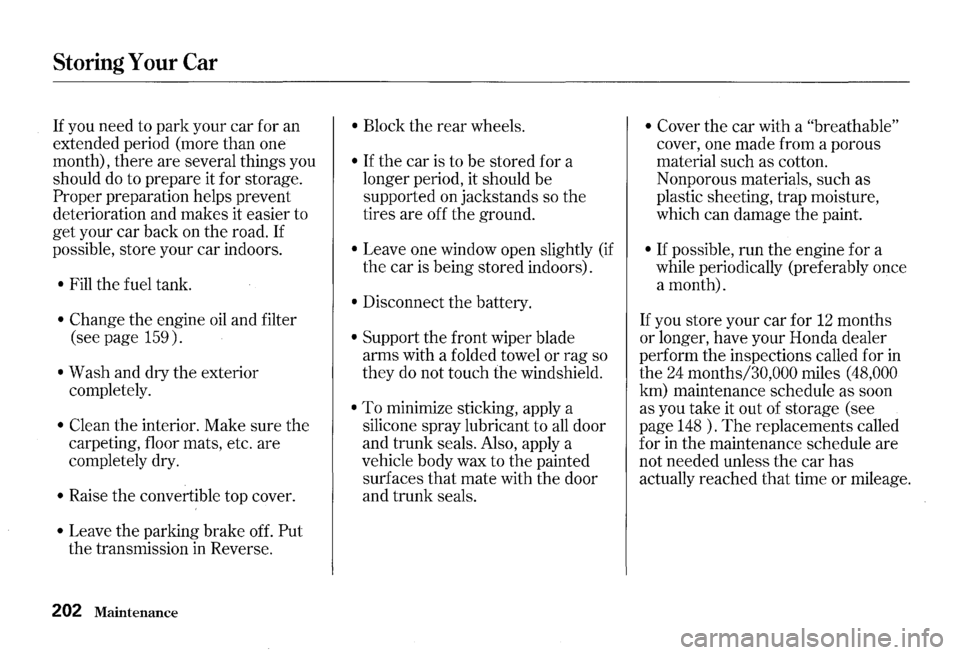Page 135 of 273
Starting the Engine
Starting in Cold Weather at High
Altitude (Above
8,000 feet/
2,400 meters)
An engine is harder to start in cold
weather.
The thinner air found at
high altitude above
8,000 feet (2,400
meters) adds to the problem.
132 Driving
Use the following procedure:
1. Turn off all electrical accessories
to reduce the drain on
the battery.
2. Push the accelerator pedal half
way to
the floor and hold it there
while starting the engine. Do not
hold the ENGINE START button
for more than
15 seconds. When
the engine starts, release
the
accelerator pedal gradually as the
engine speeds up and smooths out.
3. If the engine fails to start in step 2,
push the accelerator pedal to the
floor and hold it there while you
try to start the engine for no more
than
15 seconds. If the engine
does not start, return to step
2.
Page 146 of 273

This section explains why it is
important to keep your car well
maintained and to follow basic
maintenance safety precautions.
This section also includes
Maintenance Schedules for normal
driving and severe driving conditions,
a Maintenance Record, and instruc
tions for simple maintenance tasks
you may want to take care of
yourself.
If you have the skills and tools to per
form more complex maintenance
tasks on your Honda, you may want
to purchase
the Service Manual. See
page 259 for information on how to
obtain a copy,
or see your Honda
dealer. Maintenance
Safety .......................
144
Important
Safety Precautions .. 145
Maintenance Schedule .................. 146
Required Maintenance Record
.... 153
Owner Maintenance Checks ........ 155
Fluid Locations ............................... 156
Engine Oil ....................................... 157
Adding Oil... ................................ 157
Recommended Oil ..................... 157
Synthetic
Oil ............................... 158
Additives ..................................... 158
Changing the Oil and Filter.. .... 159
Cooling System .............................. 161
Adding Engine Coolant ............. 161
Replacing Engine Coolant ........ 163
Windshield Washers ..................... 167
6-speed Manual Transmission
Fluid ............................................
168
Differential Fluid ........................... 169
Brake and Clutch Fluid ................. 170
Brake Fluid ................................. 170
Brake System ............................. 170
Clutch System ............................ 171
Air Cleaner Element.. .................... 172
Hood Latch ..................................... 174
Maintenance
Spark Plugs ..................................... 174
Replacement ............................... 17 4
Specifications ............................. 176
Battery ............................................
177
Wiper Blades .................................. 180
Air Conditioning System ............... 182
Air Conditioning Filter, ................. 183
Drive Belt ........................................ 184
Tires ................................................ 185
Inflation ....................................... 185
Inspection ................................... 187
Maintenance ............................... 188
Tire Rotation .............................. 188
Tire Wear .................................... 188
Replacing Tires and Wheels .... 189
Wheels and Tires ....................... 190
Winter Driving ........................... 190
Snow
Tires .............................. 191
Tire Chains ............................. 191
Lights .............................................. 192
Replacing Bulbs ......................... 194
Storing Your Car ............................ 202
Maintenance 143
Page 148 of 273

Important Safety Precautions
Before you begin any maintenance,
make sure your car is parked on
level ground and that the parking
brake is set. Also,
be sure the engine
is off. This
will help to eliminate
several potential hazards:
• Carbon monoxide poisoning
from engine exhaust.
Be sure
there is adequate ventilation
whenever you operate
the engine.
• Bums from hot parts. Let the
engine and exhaust system cool
before touching any parts.
• Injury from moving parts. Do
not run the engine unless in
structed to do so. Read
the instructions
before you
begin, and make sure you have
the
tools and skills required.
To reduce the possibility of fire or
explosion, be careful when working
around gasoline or batteries.
Use a
commercially available degreaser
or
parts cleaner, not gasoline, to clean
parts. Keep cigarettes, sparks, and
flames away from the battery and
all
fuel-related parts.
You should wear eye protection and
protective clothing when working
near the battery or when using
compressed air.
Maintenance Safety
Maintenance 145
Page 180 of 273
Check the condition of your car's
battery monthly. You should check
the color of
the test indicator window,
and for corrosion on
the terminals.
Check
the battery condition by
looking at the test indicator window
on the battery.
The label on the battery explains the
test indicator's colors.
Battery
Check the battery terminals for
corrosion (a white or yellowish
powder).
To remove it, cover the
terminals with a solution of baking
soda and water.
It will bubble up and
turn brown. When this stops, wash it
off with plain water. Dry off the
battery with a cloth or paper towel.
Coat the terminals with grease to
help prevent future corrosion.
CONTINUED
Maintenance 177
Page 181 of 273
Battery
If the terminals are severely cor
roded, clean them with baking soda
and water.
Then use a wrench to
loosen and remove
the cables from
the terminals. Always disconnect
the
negative (-) cable first and recon
nect it last. Clean
the battery termi"
nals with a terminal cleaning tool or
wire brush. Reconnect and tighten
the cables, then coat
the terminals
with grease.
178
Maintenance
If you need to connect the battery to
a charger, disconnect both cables to
prevent damage to
the car's
electrical system. The battery gives off explosive
hydrogen gas during normal
operation.
A spark
or flame can cause the
battery to
explode with enough
force to
kill or seriously hurt you.
Wear protective
clothing and a
face
shield, or have a skilled
mechanic do the battery
maintenance.
Page 182 of 273
If your car's battery is disconnected
or goes dead, the audio system will
disable itself. The next time you turn
on the radio you
will see "Code" in
the frequency display. Use the
Preset buttons to enter the five-digit
code (see page
113 ) .
I NOTICE
Charging the battery with the cables
connected can seriously damage your
car's electronic controls. Detach the
battery cables before connecting the
battery
to a charger.
Battery
Maintenance 179
Page 205 of 273

Storing Your Car
If you need to park your car for an
extended period (more than one
month), there are several things you
should
do to prepare it for storage.
Proper preparation helps prevent
deterioration and makes it easier to
get your car back on the road.
If
possible, store your car indoors.
• Fill the fuel tank.
• Change the engine oil and filter
(see page 159).
• Wash and dry the exterior
completely.
• Clean the interior. Make sure the
carpeting, floor mats, etc. are
completely dry.
• Raise the convertible top cover.
• Leave the parking brake off. Put
the transmission in Reverse.
202 Maintenance
• Block the rear wheels.
• If the car is to be stored for a
longer period, it should be
supported on jackstands so the
tires are off the ground.
• Leave one window open slightly (if
the car is being stored indoors).
• Disconnect the battery.
• Support the front wiper blade
arms with a folded towel or rag so
they
do not touch the windshield.
• To minimize sticking, apply a
silicone spray lubricant to
all door
and trunk seals. Also, apply a
vehicle body wax to the painted
surfaces that mate with the door
and trunk seals.
• Cover the car with a "breathable"
cover, one made from a porous
material such as cotton.
Nonporous materials, such as
plastic sheeting, trap moisture,
which can damage
the paint.
• If possible, run the engine for a
while periodically (preferably once
a month).
If you store your car for 12 months
or longer, have your Honda dealer
perform the inspections called for
in
the 24 months/30,000 miles (48,000
km) maintenance schedule as soon
as you take it out of storage (see
page
148 ). The replacements called
for
in the maintenance schedule are
not needed unless the car has
actually reached that time or mileage.
Page 221 of 273

If Your Engine Won't Start
Diagnosing why your engine won't
start falls into two areas, depending
on what you
hear when you press
the ENGINE START button.
• You hear nothing, or almost
nothing.
The engine's starter
motor does not operate at
all, or
operates very slowly.
• You can hear the starter motor
operating normally, or the starter
motor sounds like it is spinning
faster than normal, but the engine
does not start up and run.
218 Taking Care of the Unexpected
Nothing Happens or the Starter
Motor Operates Very Slowly
When you press the ENGINE
START button, you do not hear the
normal noise of the engine trying to
start. You may hear a clicking sound
or series of clicks, or nothing at
all.
Check these things:
• Your car has the Immobilizer
System.
You should use a
properly-coded master or valet key
to start the engine (see page 59).
A key that
is not properly coded
will cause the immobilizer system
indicator
in the dash panel to blink
rapidly.
• Turn the ignition switch to ON (II).
Turn on the headlights and check
their brightness.
If the headlights
are very dim or don't light at
all,
the battery is discharged. See
Jump Starting on page 220.
• Press
the ENGINE START button,
then release
it. If the headlights do
not dim, check the condition of the
fuses.
If the fuses are 0 K, there is
probably something wrong with
the electrical circuit for the
ignition switch
or starter motor.
You
will need a qualified
technician to determine the
problem.
(See Emergency
Towing on page 238 .)